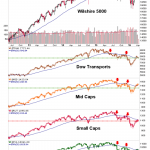A rebounding U.S. economy, as evident from the recently released improved economic data for GDP along with a favorable Consumer Confidence Index, unemployment rate and consumer spending data have all contributed to a stock market rally.
The Trump Rally has been instrumental in stock gains ever since the election. However, Trump’s failure to keep his campaign promise of revamping U.S. healthcare has put his ability to bring about tax reform under serious doubt. Although the Federal rate hike hints at a stabilized domestic economy, which is likely to sustain momentum into 2017, it failed to meet investor expectations. In fact, they expected a more aggressive rate hike forecast.
Meanwhile, per the Commerce Department, the U.S. economy expanded at an impressive rate of 2.1% in the fourth quarter, offering further evidence that the economy has entered this year on a stronger footing. Consumer spending for the said quarter was revised up to 3.5% from 3%.
Additionally, U.S. consumer confidence leaped in March to the highest level since Dec 2000 amid growing labor market optimism. Per the Conference Board, the consumer confidence index jumped to 125.6 in March from 116.1 in February, surpassing the consensus expectation of 113.
So far, the year 2017 has turned out to be a great one from the employment perspective. Employers added almost half a million jobs in the first two months of 2017, the best back-to-back performance since last summer. Not only were workers hired at a robust pace, unemployment came down and wages scaled higher. The number of people losing jobs is also at its lowest since 1973.
Major indices have done well so far in the year, with the S&P 500, the Dow Jones Industrial Average and the Nasdaq gaining 5.4%, 4.5% and 2.7%, respectively. As we move into second-quarter 2017, it’s time to make some changes to your portfolio for higher returns.
Where to Focus in Q2?
Being aware of where the market stands right now makes it possible to devise strategies to book profits in the coming days. One such timeless approach is investing in growth stocks. Growth investing, as the name suggests, offers a higher growth potential to the investors compared with other stocks in the same category. A feature of growth stocks is that they prefer to utilize the retained earnings in capital growth projects to churn out new products and develop new technology rather than making a dividend payment.












Leave A Comment